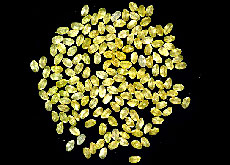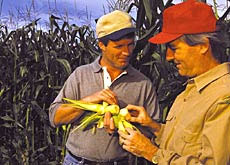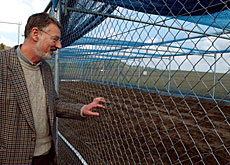GM rice controversy boils over

Scientists and environmentalists continue to be at loggerheads over a genetically modified strain of rice developed in Switzerland.
Its supporters say “golden rice” is a milestone in the history of genetic engineering, but opponents have accused them of making empty promises.
“This is intellectual fraud,” said Clément Tolusso, press officer for the environmental group, Greenpeace, in western Switzerland.
The continued debate over the pros and cons of golden rice comes as the United Nations celebrates the International Year of Rice.
In 2000 a group of researchers at the Federal Institute of Technology in Zurich succeeded in transmitting to a grain of rice the ability to produce beta-carotene – which the body coverts into vitamin A – and to increase iron content.
In Asia, where rice is the main food for millions of people, vitamin A and iron deficiency is a serious problem.
These essential dietary components are found in animal products, fruits and vegetables, which are not always available to poor families.
A lack of these nutrients can cause anaemia, vision loss or a weakened immune system, and is one reason for the high rate of mortality and illness among women and children in developing countries.
Malnutrition
Those behind golden rice believe the genetically modified organism (GMO) marks an important step in the fight against malnutrition.
“The idea is to provide a food that can at least partially make up for these deficiencies,” Rainer Holzinger, a scientist at the Institute for Plant Sciences at the Swiss Federal Institute of Technology in Zurich, told swissinfo.
But critics of golden rice and GM foods in general argue that these products are not the answer.
“The problem is not that there isn’t enough food for everyone,” says Tolusso. “It has to do with the accessibility and stockpiling of food.”
A report by the Food and Agriculture Organization (FAO) stated that the real causes of hunger and malnutrition are poverty and lack of access to food resources.
And these are two problems that transgenic foods do not address, say opponents.
Greenpeace also claims that an adult would have to eat at least 12 times the average intake of 300g of rice a day to get the daily recommended amount of vitamin A.
Wider implications
Campaigners are also concerned about the wider implications of what might happen should golden rice and other GMOs take the place of traditional crops.
Varieties created and selected through genetic engineering are richer in nutrients and more resistant, which makes them more competitive than natural strains.
But these artificial products are the property of the company that invents them. Swiss biotech firm Syngenta, the world’s leading agribusiness, holds the patent in the case of golden rice.
To fight this “undue appropriation”, around 30 Asian non-governmental organisations have written numerous letters of protest.
Farmers in developing countries, who ought to be the greatest beneficiaries of these innovations, have also come out against a globalised agricultural system dominated by multinationals such as Syngenta and Monsanto of the United States.
But researchers insist the aim of GMOs is not to create monopolies or to introduce new farming techniques, but to try to improve nutrition and health in many developing countries.
“There are various possible approaches,” said Holzinger. “Transgenic rice may be a legitimate answer.”
swissinfo, Luigi Jorio
Every year up to 2 million children die because of vitamin A deficiency.
500,000 go blind.
In 1991, researchers in Zurich and in Freiburg, Germany, genetically manipulated a laboratory variety of Japanese rice.
The rice genome was incorporated with genes from the narcissus plant and from a bacterium in order to boost production of beta-carotene, a precursor of vitamin A.
Golden rice is currently being grown on an experimental basis in the Philippines and will probably reach the market in three or four years.

In compliance with the JTI standards
More: SWI swissinfo.ch certified by the Journalism Trust Initiative




You can find an overview of ongoing debates with our journalists here. Please join us!
If you want to start a conversation about a topic raised in this article or want to report factual errors, email us at english@swissinfo.ch.